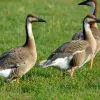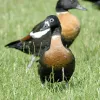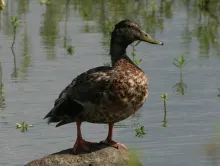
Hawaiian duck (Anas wyvilliana)
Species name
- Dutch name:
- Hawaii eend
- English name:
- Hawaiian Duck
- German name:
- Hawaiiente
- French name:
- Canard d'Hawaii
- Scientific name:
- Anas wyvilliana
Scientific classification
- Order:
- Anseriformes
- Family:
- Anatidae
- Onderfamilie:
- Anatinae
- Genus:
- Anas
Description
- Description:
Male:
Crown and hindneck blackish brown with varying amounts of green iridescence ,though not strongly so as head sometimes merely dark brown with or no green. Pale buff supercilium above dark-eye stripe, though neither of these is well defined, with pale eye-ring. Cheeks, throat and neck paler brown. Breast Rufous to purplish-brown with small, blackish spots, but can be more heavily marked. Rest of underparts warm brown, marked black and buff, with markings on flanks producing strong scalloping or, often, wavy vertical barring; more spotted on belly, vent and under tail converts. Mantle and scapulars with dark centers and broad paler edgings, but tertails paler grey-brown and unmarked; rump and upper tail coverts blackish. Tail grey, with whitish sides, sometimes brownish, the central feathers being slightly up curved. Upperwing mainly dark grey- brown, with green speculum bordered in front with whitish-buff and behind with black and then white; underwing whitish, with brown flight feathers. Bill is olive-grey, with black nail and darker base and center to upper mandible. Legs and feet orange.Female:
Breast slightly warmer, reddish-brown and eye stripe sometimes less distinct. Bill is dusky grey brown, with fleshy yellowish orange behind nail and short distance up sides of upper mandible. Legs and feet orange.Juvenile:
Duller brown with more diffuse markings on body.
- Behaviour:
Gregarious except while breeding. Found in sizeable groups in winter. Pair bonds formed between November and May.
Standard Measurements
- Body Length (cm):
- The male (drake) of the Hawaiian duck measures approximately 44-49 centimeters. The female measures approximately 44-49 centimeters.
- Body Weight (grams):
- The male will weight about 670 gram. The female will weight about 570 gram.
The weight is notoriously variable and can only be used as indication!
- Note:
Dabbling Ducks are generally hardy, easy to maintain and easy to breed. Shelter may be required by some of the smaller species in winter. They should be provided with cover (including marginal pond cover) and loafing areas as well as water. A pen which is 50% water is suggested. The water may be shallow (i.e. no more than two feet deep is required), and muddy areas for dabbling in are also appreciated. These ducks are generally good in mixed collections, although the smaller and quieter species may be bullied. Territorial disputes between ducks of the same species may be avoided by keeping only one pair of each species in an enclosure, unless the area is very large. For a single pair of ducks a pen are of 50 to 100 square metres, depending on the size of duck, should be provided.
A diet based on wheat and pellets is suggested, with maintenance pellets changed to breeders pellets for the breeding season. Bread and greenfood are also appreciated. Grit should always be available, with soluble grit (e.g. oystershell grit) as a calcium source when breeding.
Most species are ground nesters and both close ground cover and ground level nest boxes should be provided. Hand-rearing is generally preferred, as these ducks are generally poor parents in captive conditions, particularly in enclosures shared with other waterfowl. These ducks are prone to hybridization, particularly with closely related species, which should be kept apart from one another.
Hawaiian ducks are not difficult to keep; cover and loafing areas should be provided as well as water.
These ducks are easy to breed. They usually lay from April to June, in close ground cover or ground-level nest boxes.
This duck readily hybridises with Laysan duck (Anas laysanensis). Should be kept separate from this species and other closely-related (mallard-type) species to avoid hybridisation.
- Breeding:
- The female Hawaiian duck usually lays from 8-10 greenish-white eggs and incubates them for 26-28 days.
- Artificial incubating:
The ideal relative humidity for incubating most waterfowl eggs is 55% (ground nesters) and 40% (cavity nesters). The temperature is usually 37.4°C. Set ventilation as recommended by the incubator manufacturer. Eggs must be turned, either automatically or by hand, a minimum of 4 times a day. As the duckling develops there is a loss of water from the egg and the air sac gets bigger. In normal development of an egg with a 26-28 days incubation, the air sac occupies about a third of it three days earlier. Cleanliness is vital and ideally eggs should be moved to a separate hatcher at this point, where the humidity should be increased to 65% and even higher once they have pipped internally.
- Bird banding:
- Recommended closed leg band ring size for the Hawaiian duck is 9 mm.The leg band ring can only be applied on a young dabbling duck at around 10-11 days old.
- It doesn't matter what leg that you band, but it's good to have a consistent system. Suggested: Left leg = Female, Right leg = Male
- Maintenance food:
-





Lundi Regular with a protein content of 20%, valuable Spirulina and high-quality by-products is optimally balanced in its composition maintenance food for water ornamental fowl of all kinds. Especially green teal and Whistling ducks that are not dependent on a very high protein content, are well supplied.
Lundi Regular contains all the minerals and vitamins in full form that are important for the animals. Therefore also suitable as breeding food.





Floating full food for all sea ducks, green ducks, eider ducks and geese, especially in the moulting and breeding phase ideally suited. Packed with wholesome raw materials, natural vitamins and trace elements, this performance food with a protein content of 30% forms the basis for lifelong vitality.


